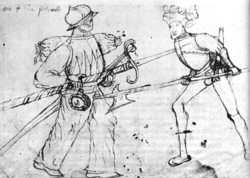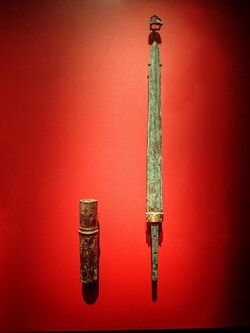Engineering:Swordstaff
A swordstaff (Svärdstav) is a Scandinavian polearm, used in the medieval ages. It is made by placing a blade at the end of a staff.[citation needed]
Evidence of the weapon in use at the Battle of Elfsborg (Alvesborg) 1502 is provided by Paul Dolnstein,[1] a landsknecht mercenary who fought in the battle, who refers to the Swedes carrying "good pikes made from swords". He also provides sketches of the weapon.[2]
Although Dolstein believed the weapon was made from swords, there is no independent confirmation of this.[citation needed]
Origins
The weapon has visual similarities to the partisan and Langue de boeuf and may share common origins. However, Scandinavian Sagas make references to a number of pole weapons, usually translated as halberd or bill.[3] These weapons are used to cut and to stab but their names suggest they were derived from the spear rather than a cutting weapon e.g. the Hewing Spear (höggspjót) and the atgeir.[4] While clearly identifiable artistic or archaeological evidence of the form of these weapons is lacking, it is possible that the swordstaff may be a late derivative of this family of weapons.
Chinese swordstaff
Chinese polearms that resembled swordstaves were also commonly used in ancient China from the late Warring States/Qin Dynasty to the Han Dynasty era. These were known as the pi (鈹), translated into English as either sword-staff or long lance, and a ranseur-like swordstaff weapon called the sha (鎩) with a blade that was around 62cm long and a hilt that was ~19cm long.[citation needed]
Notes
- ↑ https://repository.lib.ncsu.edu/bitstream/handle/1840.20/35794/etd.pdf
- ↑ John Richards : Landsknecht Soldier 1486-1560, Osprey Warrior 49, 2002 pp51-52. media:dolstein 2.gif
- ↑ *Orkisz, Jan (2016). "Pole-weapons in the Sagas of Icelanders: a comparison of literary and archaeological sources". Acta Periodica Duellatorum 4 (1): 177–212. doi:10.1515/apd-2016-0006. ISSN 2064-0404.
- ↑ "Weapons | VALHS". http://www.valhs.org/history/articles/manufacturing/text/viking_misc_weapons.htm.
External links



